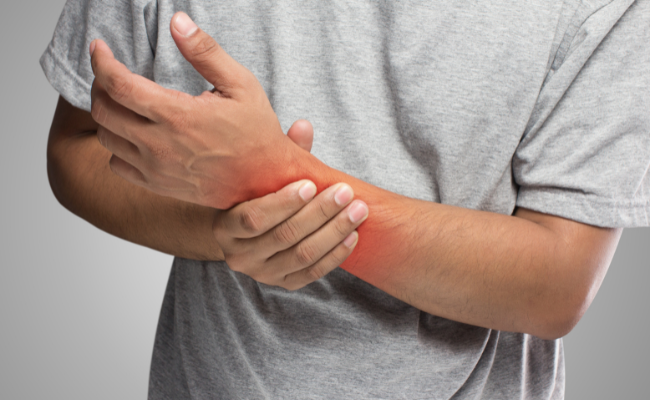How to Treat Hand Pain?
- November 08, 2023
- No Comments

What is Hand Pain?
Hand pain, a prevalent affliction, has the potential to profoundly affect one's daily life, presenting itself through a spectrum of sensations—from a persistent ache to acute, stabbing pain, often accompanied by sensations of stiffness, numbness, or tingling. The intricate composition of hands, comprising bones, joints, muscles, tendons, and nerves, renders them susceptible to various conditions that may induce pain.
Recognizing the specific cause of hand pain becomes pivotal for implementing effective treatment. The hands and wrists, forming a sophisticated network of interconnected structures encompassing bones, muscles, and joints, collaboratively enable a diverse range of activities. Yet, when hand pain emerges, it can significantly hinder an individual's ability to carry out these tasks, ultimately diminishing their overall quality of life.
Why Hand Pain occurs?
There are numerous factors that can contribute to hand pain, each requiring a tailored approach to treatment. Overuse and repetitive strain injuries, often associated with activities such as typing, writing, or using handheld tools, can lead to conditions like tendonitis or carpal tunnel syndrome. Underlying medical conditions such as arthritis, which involves inflammation in the joints, can cause persistent hand pain. Nerve compression, as seen in conditions like carpal tunnel syndrome, can result in numbness and tingling sensations.
Understanding the underlying causes of hand pain is essential because it informs the treatment strategy. A holistic approach that addresses both the symptoms and the root cause is necessary for long-term relief.
How to managing Hand Pain?
- Rest and Ice: For mild cases of hand pain caused by overuse or minor injuries, the initial step is to provide the affected hand with sufficient rest. This allows the tissues to heal. Applying ice to the affected area helps reduce inflammation and alleviate pain. It's crucial to balance rest with gentle movement to prevent stiffness.
- Stretching and Exercise: Incorporating stretching exercises into daily routines can enhance flexibility and reduce stiffness. Specific exercises targeting the hand and wrist muscles can strengthen them, providing better support to the joints. However, it's essential to perform these exercises cautiously to avoid exacerbating the pain.
- Ergonomic Adjustments: Many cases of hand pain are associated with work-related activities. Making ergonomic adjustments, such as using ergonomic tools, maintaining proper hand and wrist positioning, and taking regular breaks, can significantly reduce strain and prevent further injuries.
- Pain Medications: Over-the-counter pain relievers like ibuprofen or acetaminophen can help manage pain and reduce inflammation. However, relying on medication alone is not a long-term solution. It's crucial to use these medications as directed and consult a healthcare professional if the pain persists.
- Braces and Splints: Wearing braces or splints can provide additional support to the affected hand, especially in conditions like carpal tunnel syndrome. These devices help maintain proper alignment, reduce strain on the joints, and promote healing.
Treatment Solutions:
- Physical Therapy: A physical therapist plays a crucial role in the comprehensive treatment of hand pain. They can assess the individual's condition, design a personalized exercise program to improve strength and flexibility, and employ techniques such as ultrasound or massage to alleviate pain and promote healing.
- Occupational Therapy: Occupational therapists focus on helping individuals perform daily activities. They can provide practical strategies to adapt tasks and reduce strain on the hands. Custom splints may also be recommended to support the hand and wrist during specific activities.
- Medical Interventions: In more severe cases, medical interventions may be necessary. Corticosteroid injections can help reduce inflammation, providing relief from pain. Surgical procedures may be recommended for conditions like carpal tunnel syndrome or arthritis when conservative measures prove insufficient.
- Alternative Therapies: Some individuals explore alternative therapies such as acupuncture or chiropractic care to manage hand pain. While the effectiveness of these approaches varies, they may offer relief for some individuals under the guidance of a healthcare professional.
Benefit Points:
- Restoration of Functionality: The primary goal of treating hand pain is to restore functionality. By addressing the underlying causes and adopting appropriate treatment strategies, individuals can regain the ability to perform daily activities without discomfort.
- Pain Management: Effective treatment helps manage and alleviate pain, significantly improving the overall quality of life for those experiencing hand pain. This includes the ability to work, engage in hobbies, and enjoy recreational activities without constant discomfort.
- Prevention of Long-Term Damage: Early intervention and proper treatment can prevent the progression of hand pain into chronic conditions. By addressing the issue promptly, individuals can avoid long-term damage to the joints and tissues in the hands.
- Enhanced Mental Well-being: Chronic pain can take a toll on mental well-being. Successfully managing hand pain can contribute to improved mental health, reducing stress and enhancing overall life satisfaction.
Comments (0)